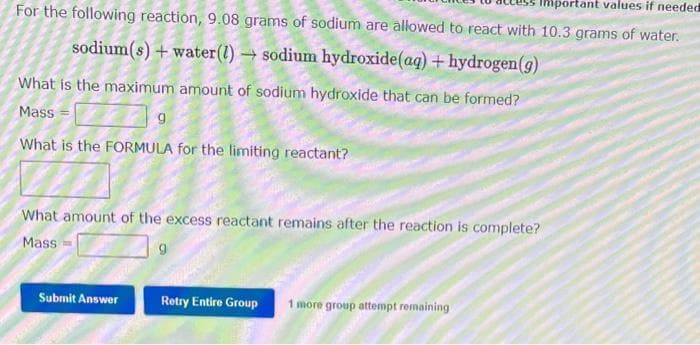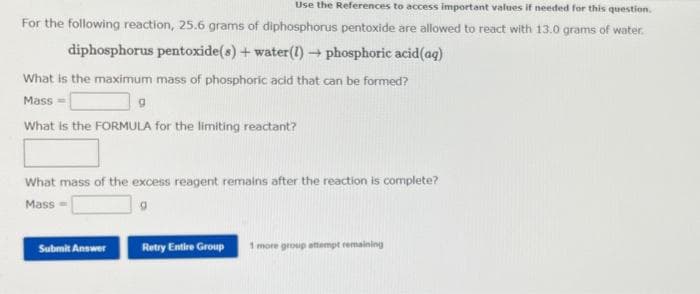important values if needec For the following reaction, 9.08 grams of sodium are allowed to react with 10.3 grams of water. sodium(s) + water(1)→ sodium hydroxide(aq) + hydrogen (g) What is the maximum amount of sodium hydroxide that can be formed? Mass What is the FORMULA for the limiting reactant? 9 What amount of the excess reactant remains after the reaction is complete? Mass 9
important values if needec For the following reaction, 9.08 grams of sodium are allowed to react with 10.3 grams of water. sodium(s) + water(1)→ sodium hydroxide(aq) + hydrogen (g) What is the maximum amount of sodium hydroxide that can be formed? Mass What is the FORMULA for the limiting reactant? 9 What amount of the excess reactant remains after the reaction is complete? Mass 9
Chemistry: The Molecular Science
5th Edition
ISBN:9781285199047
Author:John W. Moore, Conrad L. Stanitski
Publisher:John W. Moore, Conrad L. Stanitski
Chapter3: Chemical Reactions
Section3.7: Limiting Reactants
Problem 3.18E: Urea is used as a fertilizer because it can react with water to release ammonia, which provides...
Related questions
Question
Please provide only typed answer solution no handwritten solution needed

Transcribed Image Text:Important values if needed
For the following reaction, 9.08 grams of sodium are allowed to react with 10.3 grams of water.
sodium(s) + water (1)→ sodium hydroxide (aq) + hydrogen (g)
What is the maximum amount of sodium hydroxide that can be formed?
Mass
What is the FORMULA for the limiting reactant?
9
What amount of the excess reactant remains after the reaction is complete?
Mass
Submit Answer
Retry Entire Group 1 more group attempt remaining

Transcribed Image Text:Use the References to access important values if needed for this question.
For the following reaction, 25.6 grams of diphosphorus pentoxide are allowed to react with 13.0 grams of water.
diphosphorus pentoxide(s) + water (1)→ phosphoric acid (ag)
What is the maximum mass of phosphoric acid that can be formed?
Mass
What is the FORMULA for the limiting reactant?
9
What mass of the excess reagent remains after the reaction is complete?
Mass
Submit Answer
Retry Entire Group 1 more group attempt remaining
Expert Solution
This question has been solved!
Explore an expertly crafted, step-by-step solution for a thorough understanding of key concepts.
Step by step
Solved in 5 steps

Knowledge Booster
Learn more about
Need a deep-dive on the concept behind this application? Look no further. Learn more about this topic, chemistry and related others by exploring similar questions and additional content below.Recommended textbooks for you

Chemistry: The Molecular Science
Chemistry
ISBN:
9781285199047
Author:
John W. Moore, Conrad L. Stanitski
Publisher:
Cengage Learning

Chemistry: An Atoms First Approach
Chemistry
ISBN:
9781305079243
Author:
Steven S. Zumdahl, Susan A. Zumdahl
Publisher:
Cengage Learning

Chemistry
Chemistry
ISBN:
9781305957404
Author:
Steven S. Zumdahl, Susan A. Zumdahl, Donald J. DeCoste
Publisher:
Cengage Learning

Chemistry: The Molecular Science
Chemistry
ISBN:
9781285199047
Author:
John W. Moore, Conrad L. Stanitski
Publisher:
Cengage Learning

Chemistry: An Atoms First Approach
Chemistry
ISBN:
9781305079243
Author:
Steven S. Zumdahl, Susan A. Zumdahl
Publisher:
Cengage Learning

Chemistry
Chemistry
ISBN:
9781305957404
Author:
Steven S. Zumdahl, Susan A. Zumdahl, Donald J. DeCoste
Publisher:
Cengage Learning


World of Chemistry, 3rd edition
Chemistry
ISBN:
9781133109655
Author:
Steven S. Zumdahl, Susan L. Zumdahl, Donald J. DeCoste
Publisher:
Brooks / Cole / Cengage Learning

World of Chemistry
Chemistry
ISBN:
9780618562763
Author:
Steven S. Zumdahl
Publisher:
Houghton Mifflin College Div